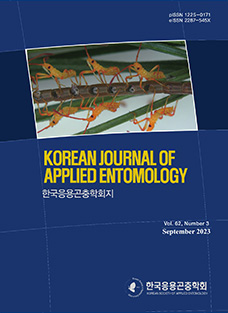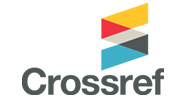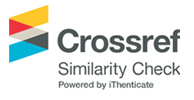The genus Euandrolaelaps consists of six species, frequently has been treated as other genera within the Laelapidae family such as Alloparasitus, Androlaelaps, Holostaspis, Hypoaspis, Laelaspis, and Pneumolaelaps (Bregetova, 1955, 1977;Karg, 1979;Ishikawa, 1982;Teng et al., 1992;Deng et al., 1993;Farrier and Hannessey, 1993). However, it was recently redefined in its correct taxonomic position by Moraes et al. (2022). The most conspicuous features of this genus are the expanded, droplet-shaped genital shield, which bears Zv1, and the remarkably developed spur-like setae on the ventral portion of the legs (Bregetova, 1955;Evans and Till, 1966;Ishikawa, 1982). In Korea, despite the absence of deposited specimens and published documentation, Euandrolaelaps pavlovskii Bregetova is included in the national species list of Korea (NIBR, 2024) based on the context provided by Seo (1983), which mentions Androlaelaps pavlovskiiBregetova, 1955 from the Democratic People’s Republic of Korea (DPRK) (NIBR, 2019). Additionally, Euandrolaelaps sardous (Berlese) was reported in Korea as Hypoaspis (Alloparasitus) sardous (Berlese) by Keum et al. (2016). However, this was later rectified as a misidentification of Laelaspis mandibularis (Ewing) (Keum et al., 2017). Euandrolaelaps yamauchii (Ishikawa) is distributed in Japan, closely resembling Eu. pavlovskii Bregetova, and only collected from abandoned mines (Ishikawa, 1982). In this study, we collected Eu. yamauchii from both the interior and exterior of caves of Korea, revised descriptions of this species after re-examining type specimens, and provide a brief diagnosis of Eu. pavlovskii Bregetova and a key to Korean Euandrolaelaps species.
Materials and Methods
Collected soil samples that consisted mostly of dried guano inside the caves and sorted by the Berlese-Tullgren funnel trap (60W, 48h). Extracted mites were preserved in 90% EtOH, cleared in lactic acid solution, and mounted in PVA medium (Downs, 1943). Specimen examinations were conducted with an Olympus BX53 compound microscope equipped with differential interference contrast optical systems. The line drawings were performed using Adobe Illustrator CC 22.0.1 software based on the original microphotographs. Digital images and morphological measurements were taken via cellSens Standard software (version 3.1). Photomicrographs were taken with an Olympus DP27 camera, selected images were stacked by Zerene stacker v.1.04 (Zerene Systems, USA). Measurements are expressed as ranges (minimum–maximum) in micrometers (μm). The length of the dorsal shield was measured from the anterior margin to the posterior margin along the midline, and the width at the level of r3, respectively. The length of the genital shield was measured from the anterior margin of hyaline extension to the posterior margin along the midline, and the width at the level of st5, the broadest area. Leg length was measured from the base of the coxa to the apex of the tarsus, excluding the pre-tarsus. The nomenclature for the dorsal idiosomal chaetotaxy follows that of Lindquist and Evans (1965), notations for leg and palp setae follow those of Evans (1963a, 1963b), and other morphological structures generally follow Evans and Till (1979). Notations for idiosomal pore-like structures (gland pores and poroids/lyrifissures) and peritrematal shields follow mostly Athias-Henriot (1971, 1975) and Moraes et al. (2022). The notations for pore-like structures on the sternal shield and the peritrematal shield region also follow modifications and additions by Johnston and Moraza (1991) and Moraes et al. (2022). To re-examine the detailed morphological characteristics of the species, holotype and allotype specimens were used that were deposited at the National Museum of Nature and Science, Tsukuba, Ibaraki, Japan. Collected Korean specimens through this study are deposited at the National Institute of Biological Resources (NIBR) and the Laboratory of Insect Biosystematics, Seoul National University (SNU), Republic of Korea.
Systematic Accounts
Family Laelapidae Canestrini, 1891
Genus EuandrolaelapsBregetova, 1977
Type species: Laelaps (Androlaelaps) sardous Berlese, 1911
Diagnosis — The concept of Euandrolaelaps used here is based on that of Moraes et al. (2022).
Euandrolaelaps pavlovskii (Bregetova, 1955) 참뿔다리가시 응애(개칭)
Androlaelaps pavlovskiiBregetova, 1955.
Hypoaspis (Euandrolaelaps) pavlovskii - I shikawa, 19 82: 91.
Hypoaspis (Laelaspis) pavlovskii - Deng et al., 1993: 174.
Euandrolaelaps pavlovskii - Moraes et al., 2022: 239.
Diagnosis. Adults. In female, body oval-shaped, 0.8–0.95 mm in length, 0.46–0.56 mm in width; dorsal shield bearing 38 pairs of acicular setae, 22 pairs on podonotal region (j1–j6, z1–z6, s1–s6, and r2–r5) and 16 pairs on opisthonotal region (J1–J5, Z1–Z5, S1–S5, and Zx). In ventral, six to seven pairs of setae bearing soft integument; a pair of small additional platelets located at level of Zv1. In male, body oval-shaped, (0.72–0.86 mm long × 0.4–0.48 mm wide) a pair of metapodal plates present.
Distribution. Eastern Siberia and Far East Russia, China (Vinarski and Korallo-Vinarskaya, 2016); Pakistan (Halliday et al., 2018); Korea (Seo, 1983;NIBR, 2024)
Remarks. Since this species was recorded based on the data from DPRK without any available specimen and detailed description, the diagnosis was referred to Bregetova (1955) and Moraes et al. (2022).
Euandrolaelaps yamauchii (Ishikawa, 1982) 동굴뿔다리가 시응애(신칭) (Figs. 1–6)
Hypoaspis (Euandrolaelaps) yamauchiiIshikawa, 1982: 89.
Alloparasitus yamauchii - Moreira, 2014: 113.
Euandrolaelaps yamauchii - Moraes et al., 2022: 240.
Specimens examined. Holotype: coll#: NSMT-Ac 14774; Allotype: coll#: NSMT-Ac 14775. Korean specimens. Two ♀ ♀ and two ♂♂, Cave. Baeti shale, 674 Sayang-ri, Ssangchaekmyeon, Hapcheon-gun, GN, Korea, 17. iv. 2021., J Oh coll; one ♀, Cave. Maguihalmigul, 595-3, Nakpung-ri, Okgyemyeon, Gangreung-si, GW, Korea, 24. iv. 2021., J Oh coll; one ♀, Mt. Gariwangsan, 115-2, Jangjeon-ri, Jinbu-myeon, Pyeongchang-gun, GW, Korea, 12. vi. 2021., J-H Oh coll.
Redescription (adult female) (Figs. 1–2 & 5)
Four specimens measured (including Holotype female)
Dorsal idiosoma — (Figs. 1–2 & 5) — Dorsal shield oval, dome-shaped (786–920 long × 534–652 wide) covering whole dorsum; anterior and posterior margin of dorsal shield round; surface covered with fainted scale-like reticulation, 37 pairs of acicular setae bearing on dorsum, including 22 pairs on podonotal region (j1–6, z1–6, s1–6, and r2–5) and 15 pairs of opisthonotal region (J1–5, Z1, Z2, Zx, Z4, Z5, and S1–5); Most dorsal setae extended (79–121), J5, Z5, and S5 slightly serrated, z1 shortest (29–42); nine pairs of discernible pore-like structures, including eight pairs of poroids and two pairs of gland openings (gd6 and gd8) (Figs 1A, 2A, 5A & 5C).
Ventral idiosoma — (Figs 1–2 & 5) — Tritosternum with a pair of pilose laciniae (117–126) and long columnar base (39 –53 long × 19–23 wide) (Fig 2B). Presternal platelet welldeveloped, covered with lineate reticulation, posterior margin closely abutted to anterior margin of sternal shield (Figs 1B, 1C, 2B & 5D). Sternal shield enlarged (184–208 long × 215– 263 wide) with distinct reticulation thoroughly, anterior margin nearly straight, and posterior margin concaved; three pairs of smooth setae (st1: 77–92, st2: 74–84, st3: 71–81) and two pairs of poroids (iv1, iv2) bearing on shield, metasternal shield absent, st4 (72–101), and iv3 bearing on soft integument (Figs. 1B, 1C, 2B & 5D). Endopodal plates I/II and II/III completely fused with sternal shield; endopodal plates III/IV elongated, curved, and anterior tip of plates fused with posterolateral margin of sternal shield (Figs. 1B, 1C, 2B & 5D). Genital shield flask-shaped (356–396 long × 209–236 wide), covered with longitudinal reticulation, largely expended at level of Zv1, anterior hyaline margin of shield convexed, slightly overlapped posterior area of sternal shield; genital shield bearing two pairs of setae st5 (61–71) and Zv1 (73– 83), a pair of paragenital poroids iv5 located on soft integument (Figs. 1B, C & 2B). Anal shield subtriangular-shaped subequal in length and width (115–135 long × 109–149 wide), bearing a pair of para-anal setae (46–62) and a single post-anal seta (36–37); anal cribrum consisting with irregular rows of spicules and a pair of arms extended over para-anal setae (near level of Zv4) (Figs. 1B, E & 2B). Soft opisthogastric integument with two pairs of metapodal plates and 12 pairs of acicular-shaped ventral setae (r6, Jv1–5, Zv2–4, UR1–3) (47–107), Jv4, Jv5, and UR3 slightly serrated (Figs 1B, 2B). Exopodal plates I/II fused with anterolateral corner of sternal shield, a pair of subtriangular exopodal plates II/III present; parapodal plates surrounded coxa IV not fused with posterior tip of endopodal plate (Fig. 2B). Peritrematal plates welldeveloped, poststigmatic extension with a pair of large poroid; peritremes extending to level of anterior margin of coxa II (Figs 1B, 2B).
Gnathosoma — (Figs. 1–2 & 5) — Anterior margin of epistome slightly convexed with minute serrations (Figs. 1G, 2D & 5E). Hypostome with four pairs of smooth setae, h3 (75 –93) > pc (66–84) > h1 (62–75) > h2 (52–63); deutosternal grooves with six transverse rows of denticle, each row with 6 –18 tiny denticles; corniculi (68–82) sword-like, extending at level of palpfemur; internal malae with three pairs of fimbriate projections, a pair of median projection elongated, two pairs of lateral projections relatively short (extended 1/3 level of median projection); labrum with pilose surface and margin (Figs. 1F, 2E & 5B). Setal counts of palp (224–267): trochanter 2, femur 5, genu 6, tibia 14; most of setae smooth, palp genu with spatulated al1 (23–28) (Fig. 1F, enlarged photo); palptarsal apotele three-tined. Fixed digit (90–121) of chelicera with an offset distal tooth (gabelzhan), followed by two large teeth and 10 small teeth (13 teeth in total); a setaceous pilus dentilis situated behind 2nd large teeth, overlapped with 1st small teeth, cheliceral seta thick and aciculate; movable digit (105–112) bidentate, arthrodial membrane with a round flap and filaments (Figs. 1I, 2F).
Legs — (Figs. 1–2 & 5) — Legs II (615–775) and III (625 –728) relatively short, Legs IV (873–1024) and I (808– 901) longer. Chaetotaxy: Leg I: coxa (2) 0 - 0/1, 0/1 - 0 (gc present), trochanter (6) 1 - 1/1, 1/1 - 1, femur (13) 2 - 3/1, 2/3 - 2, genu (13) 2 - 3/2, 3/1 - 2, tibia (13) 2 - 3/2, 3/1 - 2. Leg II (Figures 1H, 2C): coxa (2) 0 - 0/1, 0/1 - 0, trochanter (5) 1 - 0/1, 1/1 - 1, femur (11) 2 - 3/1, 2/2 - 1, genu (11) 2 - 3/1, 2/1 - 2, tibia (10) 2 - 2/1, 2/1 - 2. Leg III: coxa (2) 0 - 0/1, 0/1 - 0, trochanter (5) 1 - 0/1, 1/1 - 1, femur (6) 1 - 2/1, 1/0 - 1, genu (9) 2 - 2/1, 2/1 - 1, tibia (9) 2 - 1/1, 2/1 - 2 (pl2 present). Leg IV: coxa (1) 0 - 0/1, 0/0 - 0, trochanter (5) 1 - 1/2, 0/1 - 0, femur (6) 1 - 2/1, 1/0 - 1, genu (10) 2 - 2/1, 3/0 - 2 (pl2 present), tibia (10) 2 - 1/1, 3/1 - 2. Tarsi II–IV with 18 setae (3 - 3/2, 3/2 - 3 + md, mv). Femur II (32–35) and genu II (15–21) with spur-like modified setae (av), tibia II with spine-like modified setae (av, pv) (45–60). All pretarsi with well-developed paired claws, pulvilli, and ambulacral stalk (Figs. 1H, 2C & 5F).
Redescription (adult male) (Figs. 3–4 & 6)
Three specimens measured (including Allotype male)
Dorsal idiosoma — (Fig. 6) — Dorsal shield 728–799 long, 458–485 wide; ornamentation and chaetotaxy as in female (Figs. 6A, C).
Ventral idiosoma — (Figs. 3–4 & 6) — Presternal platelet present, sternal, genital, endopodal, ventral, and anal shield fused into holoventral shield, 603–623 long from anterior to posterior margin of shield, 285–300 wide at level of broadest point (Zv1); shield reticulate throughout, with 10 pairs of smooth setae (st1–5, Jv1–3, Zv1, Zv2) (47–75) and five pairs of poroids (iv1–3, iv5, ivo); anal cribrum with irregular rows of spicules and a pair of arms extended over para-anal setae; metapodal platelets not discerned; soft opisthogastric integments with a pair of Jv4 (Figs. 3A, 4A & 6D). Peritremes, peritrematal shields, and other ventral structures similar to those in female.
Gnathosoma — (Figs. 3–4 & 6) — Fixed digit unidentate with apical hook, pilus dentilis setaceous (Figs. 3B, 4B). Movable digit with a large tooth, spermatodactyl closely abutted to movable digit without free portion, apical corner curved to 90 degrees (75–79 long × 27 wide) (Figs. 3B, 4B). A pair of small hump-like projections located between h1 and h3; first row of deutosternal denticles pointed, located at level of humps (Figs. 3C, 6B). Other gnathosomal structures similar to those in female (Fig. 6E).
Legs — (Figs. 3–4 & 6) — Legs length: leg IV (884–915) > leg I (794–818) > leg II (641–675) > leg III (597–644). Leg II and IV with spur-like modified setae {femur II av (31– 52), pl2 (20–25); genu II av (15–18); tibia II av, pv (35–43); genu IV pv; tibia IV pv (85–106)} (Figs. 3D–E, 4C–D & 6F –G). Chaetotaxy as in female.
Distribution. Japan (Ishikawa, 1982); Korea (this study).
Remarks According to the plates of Ishikawa (1982), Eu. yamauchii has five rows of deutosternal grooves, and the anterior tip of the endopodal plates II/III appears to be closely abutted to the posterolateral margin of the sternal shield, not fused. However, upon examining both the type series and the Korean specimens, we observed six rows of deutosternal grooves and fused endopodal plates. Since the previous author only provided the drawing plates without further description, we hereby present a revised description of Eu. yamauchii.
Key to species of the Korean species of genus Euandrolaelaps
-
1. 38 pairs of dorsal setae (Z3 present); seven pairs of setae on ventral integument; leg II without ventral spurs; two-tined palp apotele; in male, a pair of metapodal plates present at the level of Zv2; associated with rodents ········ ············································· Eu. pavlovskii (Bregetova)
-
- 37 pairs of dorsal setae (Z3 absent); 11 pairs of setae on ventral integument; leg II with stout ventral spurs; threetined palp apotele; in male, metapodal plates absent; cave-dweller ··························· Eu. yamauchii (Ishikawa)














 KSAE
KSAE





